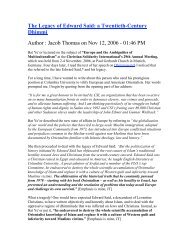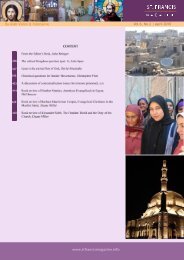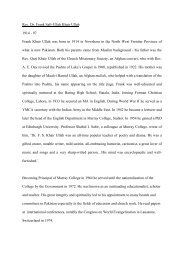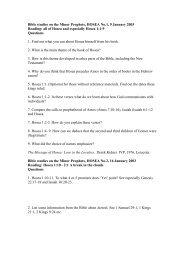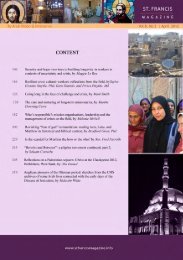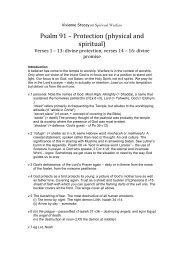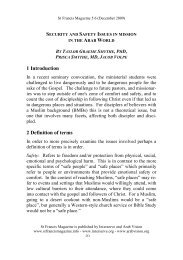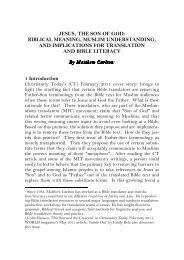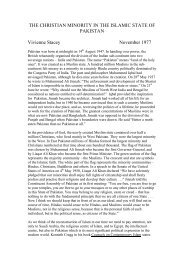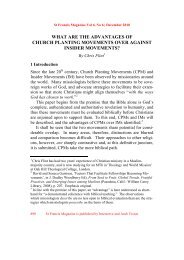Download the pdf - St.Francis Magazine
Download the pdf - St.Francis Magazine
Download the pdf - St.Francis Magazine
You also want an ePaper? Increase the reach of your titles
YUMPU automatically turns print PDFs into web optimized ePapers that Google loves.
<strong>St</strong> <strong>Francis</strong> <strong>Magazine</strong> Vol 9, No 4 | August 2013<br />
communicate <strong>the</strong> gospel into <strong>the</strong> cultures of North Africa, this western expression of <strong>the</strong> Christian<br />
faith was not sufficient as a criterion for selecting candidates.<br />
3. Target Audience and Preferred Languages<br />
3.1 Aiming at North Africa<br />
As NAM only worked in North Africa when it began its broadcasting ministry during <strong>the</strong> 1950s,<br />
it was so obvious that <strong>the</strong> organization was to produce programs for North Africa that no formal<br />
decision regarding its intended target audience seems to have been taken.<br />
In 1974 George Rider, director of RSB at that time, was convinced <strong>the</strong>y were reaching <strong>the</strong><br />
educated people of North Africa, and he was satisfied with that. ‘I still feel that we are reaching […]<br />
<strong>the</strong> educated people. A number of letters are coming in; we are reaching <strong>the</strong> educated people<br />
through an educated presentation of <strong>the</strong> Gospel.’ 106 That was logical, as RSB used MSA as <strong>the</strong><br />
language of <strong>the</strong> programs, and that could only be understood by <strong>the</strong> educated elite. Moreover, those<br />
who were able to write back to RSB were also those who could read and write.<br />
In 1980, RSB was speaking in much broader terms about its intended audience. ‘Our objective is<br />
to reach as many Muslim people as possible. We try to transmit in a manner which will attract as<br />
wide an audience as possible ra<strong>the</strong>r than just a few people,’ Harris and Sīkālī published in 1980. 107<br />
This statement was probably for public relations only, as RSB knew its main audience was better<br />
educated.<br />
Ken McBride, <strong>the</strong> director of RSB from 1979-1984, described <strong>the</strong> target audience of Light upon<br />
Light in 1982:<br />
Target audience of Nour ala Nour (Light upon Light) in standard Arabic is Arabic speaking North Africans<br />
18-26 years old with at least 3-4 years of secondary education. They can use standard Arabic. We believe<br />
<strong>the</strong>y are open to change because of confusion over values (traditional vs. modern secular) and frustration in<br />
<strong>the</strong>ir search for more education, work, marriage etc. It is also a time of life when people check out <strong>the</strong><br />
options before making or confirming <strong>the</strong>ir major life commitments. 108<br />
McBride’s assumption that North Africans with three or four years of secondary schooling would<br />
be able to meaningfully use MSA was too optimistic and it is contradicted by research done all over<br />
<strong>the</strong> Arab world. 109<br />
3.2 Preference for MSA<br />
In August 1958, when Field Administration meetings in North Africa discussed <strong>the</strong> issue of<br />
becoming involved in program production, <strong>the</strong> term ‘North African colloquials [sic]’ was used. This<br />
gives <strong>the</strong> impression that from <strong>the</strong> beginning of NAM’s interest in broadcasting, it wanted to do so<br />
in <strong>the</strong> spoken languages of North Africa. This might mean NAM considered broadcasting in<br />
Amazigh languages or colloquial Arabic. If NAM had thought of broadcasting in MSA, <strong>the</strong> minutes<br />
would have spoken about ‘Arabic’, not ‘North African colloquials’. 110<br />
NAM’s Field Council decided in 1959 that a start had to be made with simple Scripture readings<br />
in Arabic, colloquial, and Amazigh dialects. Later o<strong>the</strong>r types of programs had to be developed and<br />
would include ‘Classical Arabic and French.’ 111 This underlines that NAM’s initial preference was for<br />
broadcasting programs in colloquial Arabic, not in MSA. Harris wrote in 1959 that it ‘has long been<br />
<strong>the</strong> prayer of missionaries […] that Gospel programs in colloquial Arabic might one day be heard in<br />
106 Transcript of a speech by George Rider, ‘Demonstration of Media Solution– Case Histories’ (20 February 1974,<br />
Marseille), p. 3, from <strong>the</strong> Archives of <strong>the</strong> Billy Graham Center at Wheaton College, Collection 86, Box 27, Folder 28.<br />
107 Harris and Sikaly, ‘What’s Happening in 1980’, p. 5.<br />
108 Ibid.<br />
109 More on this issue is treated in chapter 3 of <strong>the</strong> <strong>the</strong>sis, on languages and literacy in <strong>the</strong> Arab world.<br />
110 Harold W. <strong>St</strong>alley, ‘Memorandum to Home Councils, Report of Field Administration (29 July-2 August 1958)’, p. 3,<br />
from <strong>the</strong> NAM/AWM files in Worthing.<br />
111 ‘Minutes of Meeting of Field Council held at Tangier (22-24 September 1959)’, p. 3.<br />
<strong>St</strong> <strong>Francis</strong> <strong>Magazine</strong> is published by Arab Vision and Interserve 15


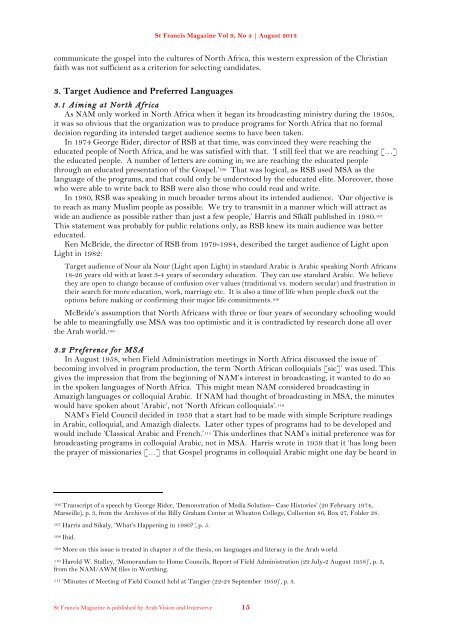

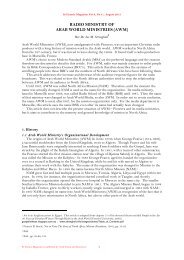
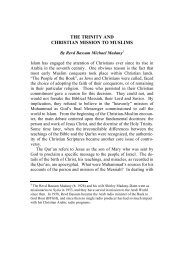
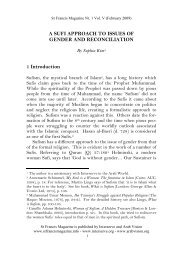
![Reflections on Surah Fatiha and the Lord's Prayer[1] - St.Francis ...](https://img.yumpu.com/49377951/1/184x260/reflections-on-surah-fatiha-and-the-lords-prayer1-stfrancis-.jpg?quality=85)
